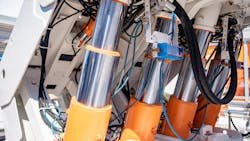Matching a Pneumatic Cylinder’s Output to the Application
Pneumatic cylinders and actuators are much like their hydraulic and electric counterparts: Their main task is to generate enough force to move a load from one point to another. But how much force is needed in specific applications? Although calculating the theoretical force output is fairly straightforward, properly sizing a pneumatic cylinder for an application is much more challenging.
Following are some simple tips that will help engineers determine the right cylinder for the task at hand.
Calculate the force. A pneumatic actuator exerts a force that can be calculated using the equation F = PA, where A is the pneumatic piston’s usable area and P is air pressure. For example, a cylinder with a 1.5-in. bore and an extend force of 80 psi generates (80 x (1.5/2)2 x π) or 141 lb. of force. But this is the theoretical amount of force exerted. Several other factors work to reduce the amount of force actually applied. So, keep the following issues in mind when sizing a cylinder.
If needed, subtract the rod area. The theoretical force is the usable piston area multiplied by air pressure. If using the return stroke, or a double-rod cylinder, however, the rod area must be subtracted from the usable piston area.
Know the operating pressure. A compressor might be rated to handle a certain pressure, but the pressure the cylinder sees in operation can be much lower due to other equipment's air consumption or other air-supply restrictions. An air supply running at 100 psi may drop to 80 psi or lower during peak air use times.
Allow for internal friction. Internal friction generated by seals, bushings, wear bands, and supports prevent cylinders from ever reaching their theoretical maximum force outputs. The loss in force is typically 1 to 10 psi of the cylinder’s theoretical force output, depending on the type of seal. Cylinders with side loads, misalignments or specialty features have even higher levels of internal friction.
Know the true load. Unless the load is being lifted vertically and is not guided, it can be challenging to determine the true load. For example, determining force loss due to sliding friction is calculated using Friction Force = Friction Coefficient × Normal Force. Unfortunately, the coefficient of friction is often difficult to determine. And while there are tables that list coefficients of friction for various materials, there can be small variations in the coefficient’s value and these small variations can make a big difference in calculating the required force.
Engineering teams sizing a cylinder for an existing application that are stymied in their pursuit of the required force should try to physically measure it. If it is a new application, carry out as many experiments as possible to prove the initial calculations.
Add speed requirements to the equation. Acceleration equals excess force divided by the total mass being moved (A = F/m). Total mass includes the mass of the cylinder and piston-rod assembly. But air must get into the piston quickly enough to build enough pressure to generate the required acceleration force and speed. If this is a concern, contact the distributor/supplier for help in determining the actuator’s performance characteristics.
Consider the angles. When dealing with linkages or force-transfer angles, allow for force losses in angles. For example, forces in an application decrease when they work against a pin or other pivoting member instead of directly on the load.
The force transferred in an application is equal to the total force × sin(transfer angle). And the force absorbed by the pivot equals total force × cos(transfer angle). When the transfer angle is above 135 deg. or below 45 deg., more cylinder force acts against the pivot than gets transferred to the application. Transfer angles above 150 deg. and below 30 deg. should be avoided because they transfer less than half the cylinder force to the application.
Allow for future changes. It is wise for the design team to make allowances in the design to handle slight increases in performance requirements or unforeseen force losses. Adding new equipment, however, may affect the available air pressure. A regulator can reduce output forces, but it’s not so easy to add forces.
Consider kinetic energy. Don’t overlook the kinetic energy associated with a moving load. Cylinders can absorb some kinetic energy, but their primary task is converting pressure into linear force. Adding a shock absorber can eliminate the potential danger posed by a fast moving mass.
Test the results. Sizing a cylinder for an application without any testing can be a major mistake. Once a product is built, it can be costly to make changes such as increasing the bore size. Tandem cylinders can increase the force and extend the cylinder length, but they are less efficient than simply using a larger-bore cylinder to begin with. Unless there are strict air consumption or time requirements, it is a good idea to oversize the cylinder.
This article was written and contributed by Joe Malloy, chief engineer at Numatics Actuator, and was originally published in Machine Design, an affiliate publication to Power & Motion.
